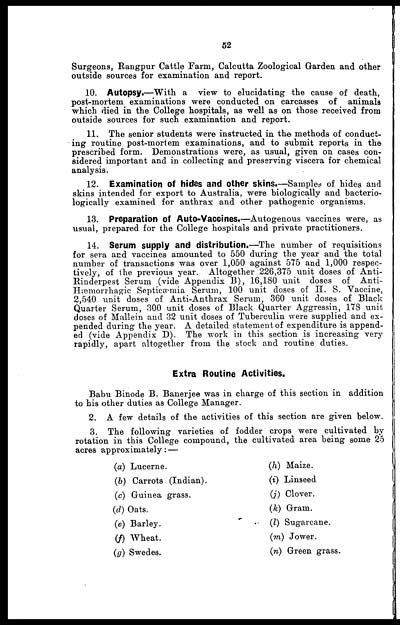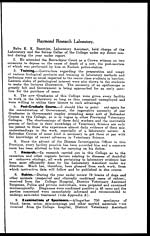Medicine - Veterinary > Civil Veterinary Departments > 1895-1951 - Annual report of the Civil Veterinary Department, Bengal > 1923-1933 - Civil Veterinary Department Bengal reports 1923-33 > Annual report of the Civil Veterinary Department, Bengal and Bengal Veterinary College for the year 1932-33
(568) Page 52
Download files
Individual page:
Thumbnail gallery: Grid view | List view

52
Surgeons, Rangpur Cattle Farm, Calcutta Zoological Garden and other
outside sources for examination and report.
10. Autopsy.—With a view to elucidating the cause of death,
post-mortem examinations were conducted on carcasses of animals
which died in the College hospitals, as well as on those received from
outside sources for such examination and report.
11. The senior students were instructed in the methods of conduct-
ing routine post-mortem examinations, and to submit reports in the
prescribed form. Demonstrations were, as usual, given on cases con-
sidered important and in collecting and preserving viscera for chemical
analysis.
12. Examination of hides and other skins.—Samples of hides and
skins intended for export to Australia, were biologically and bacterio-
logically examined for anthrax and other pathogenic organisms.
13. Preparation of Auto-Vaccines.—Autogenous vaccines were, as
usual, prepared for the College hospitals and private practitioners.
14. Serum supply and distribution.—The number of requisitions
for sera and vaccines amounted to 550 during the year and the total
number of transactions was over 1,050 against 575 and 1,000 respec-
tively, of the previous year. Altogether 226,375 unit doses of Anti-
Rinderpest Serum (vide Appendix B), 16,180 unit doses of Anti-
Hæmorrhagic Septicæmia Serum, 100 unit doses of H. S. Vaccine,
2,540 unit doses of Anti-Anthrax Serum, 360 unit doses of Black
Quarter Serum, 300 unit doses of Black Quarter Aggressin, 178 unit
doses of Mallein and 32 unit doses of Tuberculin were supplied and ex-
pended during the year. A detailed statement of expenditure is append-
ed (vide Appendix D). The work in this section is increasing very
rapidly, apart altogether from the stock and routine duties.
Extra Routine Activities.
Babu Binode B. Banerjee was in charge of this section in addition
to his other duties as College Manager.
2. A few details of the activities of this section are given below.
3. The following varieties of fodder crops were cultivated by
rotation in this College compound, the cultivated area being some 25
acres approximately:—
(a) Lucerne.
(6) Carrots (Indian).
(c) Guinea grass.
(d) Oats.
(e) Barley.
(f) Wheat.
(g) Swedes.
(h) Maize.
(i) Linseed
(j) Clover.
(k) Gram.
(l) Sugarcane.
(m) Jower.
(n) Green grass.
Set display mode to: Large image | Zoom image | Transcription
Images and transcriptions on this page, including medium image downloads, may be used under the Creative Commons Attribution 4.0 International Licence unless otherwise stated. ![]()
| Permanent URL | https://digital.nls.uk/77009441 |
|---|




